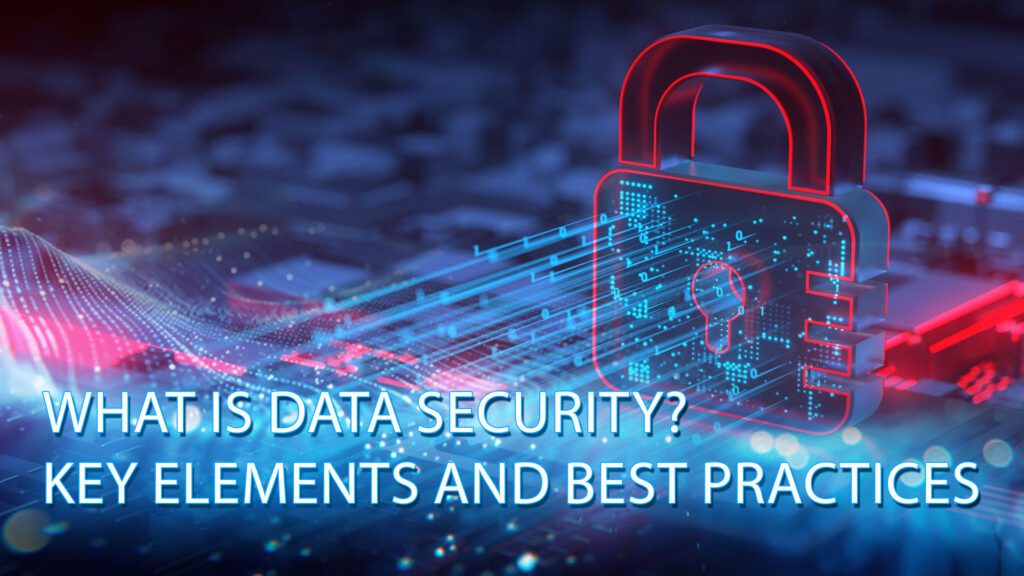As data breaches in organizations become more frequent, understanding what data security is is something that every company that does business based on data should understand and grasp. This article by DIGI-TEXX will answer the question What Is Data Security, explain its importance, highlight key threats, and provide standards that businesses of all sizes can follow.

What Is Data Security?
Data security is the measures used to protect data from being stolen and leaked, and is evaluated based on four aspects: data confidentiality, data integrity, and data availability.
Data security includes policies, processes, and technologies designed to prevent unauthorized data destruction, unauthorized modification, or disclosure of information. An effective data security strategy not only protects data while it is being stored, but also while it is being transmitted and processed, ensuring that the organization’s security data is always safe from any potential threats or unforeseen incidents.

Why is Data Security Important?
The importance of data security should not be underestimated, especially when data breaches with potentially devastating financial and reputational consequences are becoming more frequent for large companies and brands. Having a robust data security standard in place provides a number of core business benefits.
- Protecting Sensitive Information: A properly implemented data security standard will protect personal, financial and other sensitive information from being misused or stolen by malicious actors.
- Maintaining Business Operations: Ensuring data availability is critical to maintaining business continuity and preventing disruption when data becomes compromised.
- Complying with Regulations: With the requirements of today’s data standards, organizations now have to protect specific types of data, such as privacy regulations (e.g. GDPR, CCPA).
- Building Trust: Good data security practices help build and maintain trust with customers, partners, and stakeholders.
- Avoiding Financial Losses: When a data breach occurs, it can result in significant financial losses through legal penalties, fines, and remediation costs.
- Protecting Reputation: A data breach can severely damage an organization’s image and brand.

Biggest Data Security Threats
To build an effective data security standard, understanding the biggest threats to data security is a critical first step. These threats are constantly evolving in sophistication, requiring organizations to stay up to date with their data security solutions.
Cyberattacks (phishing, malware, ransomware)
Cyberattacks are one of the most common and dangerous threats to data. Attacks such as phishing, which lure users into revealing sensitive information, malware, which infiltrates and destroys systems from within, and ransomware, which encrypts data and demands a ransom to restore it. These attacks can cause serious disruptions and huge financial losses.
Insider threats
Insider threats come from individuals with legitimate access to an organization’s systems, including employees, contractors, or partners. These threats can be accidental (due to negligence) or intentional (due to malicious intent). An employee accidentally sending an email containing sensitive data to the wrong person or a disgruntled employee deliberately stealing customer data are all examples of major data security failures.
Human error
The human factor remains one of the most important links in the data security chain. Human errors, such as using weak passwords, failing to update software, clicking on suspicious links, or misconfiguring security systems, can unintentionally create serious vulnerabilities that hackers can exploit to gain access to a company’s network.

Key Elements of Data Security
An effective data security management strategy is built on foundational elements, commonly known as the CIA Triad (including Confidentiality, Integrity, Availability) and complementary principles. These elements form a comprehensive framework for protecting data in all its states.
Confidentiality
Confidentiality ensures that data is only accessible to authorized users. This element focuses on preventing the disclosure of sensitive information to unauthorized or unauthorised individuals, entities, or processes. Measures such as encryption and access control play a central role in maintaining security.
Integrity
Integrity is the maintenance of the consistency, accuracy and reliability of data throughout its lifecycle. This means that the data has not been altered or destroyed in an unauthorized manner. Mechanisms such as checksums and digital signatures are used to detect any changes to the data.
Availability
Availability ensures that authorized users can access data and related resources in a timely and uninterrupted manner when needed. This is critical to business continuity and is typically ensured through system maintenance, redundancy and disaster recovery plans or objective incidents.
Authentication & Access Control
Authentication and Access Control are mechanisms used to verify the identity of users and limit their access to data. Authentication ensures that users are who they say they are, while access control (based on the principle of least privilege) grants users access only to the data they need to perform a specific task, and they are not allowed access to other parts of the data.
Encryption
Encryption is the process of converting data from a readable form to an unreadable format (ciphertext) using an algorithm. Only those with the correct decryption key can convert the data back to its original form. Encryption is one of the most powerful tools for protecting security data, especially when the data is being stored or transmitted.

Best Practices for Data Security
Implementing data security best practices is key to protecting your organization from increasingly sophisticated threats. A proactive approach can help reduce risk and build a more secure digital environment that follows data security standards.
- Secure your information: This means managing who has access to and encrypting data. Only those who need to make changes to data should have access, and information should be encrypted when moving between the database and a computer or device.
- Prepare ahead of time for threats: Make sure your organization is ready for a potential data security incident by testing your systems, training your employees, developing an incident management plan, and creating a backup and recovery plan after an incident.
- Delete data you are not using: It is recommended to include a standard for removing both digital and physical copies of data that the business no longer needs. This will also reduce the chances of a hacker discovering and using it for profit.

In short, understanding what data security is is the first step in building a solid digital “fortress” for any business. From identifying threats, mastering core elements, to applying the right methods, all contribute to a comprehensive data security strategy. Investing in data security management is not only an urgent measure but also a strategic investment that helps protect reputation, maintain business continuity and build sustainable trust with customers.
At DIGI-TEXX, we understand that data is an invaluable asset. With advanced data analysis and processing solutions, we always put security first, helping your business not only maximize the value of data but also ensure absolute safety for them. Contact DIGI-TEXX today for advice on comprehensive data analysis and security solutions.
=> Read more:


